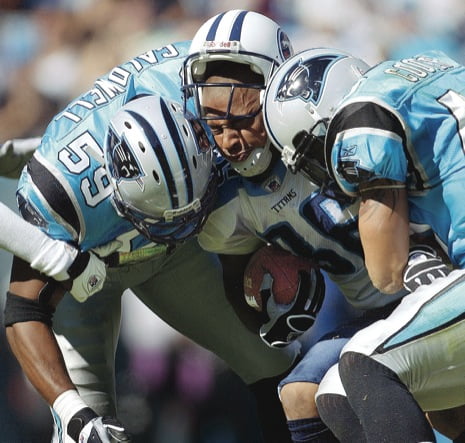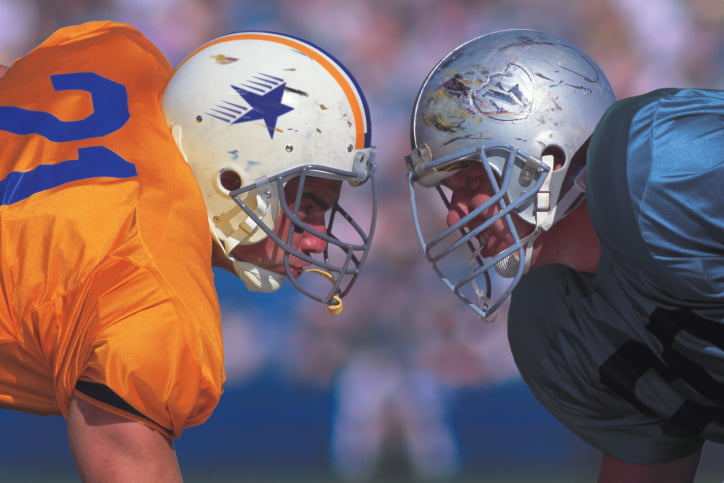According to data by the National Football League (NFL) up to 30 percent of former major league football players will develop Alzheimer’s disease or dementia at some point in their lifetime. This means that the men who sprint, tackle and pitch down the field have a chillingly higher risk of developing serious brain disorders in comparison to the general population.
However, a new MRI diagnostic approach developed in Israel may be able to halt some of the significant brain damage before a player experiences one-too-many bad tackles. By identifying damage to the player’s blood-brain barrier (BBB), or the fine line separating the blood of the brain from the fluid in the nervous system, a new study could help players make more educated decisions regarding the future of their football careers.
SEE ALSO: The Top 10 Israeli Startups Changing The World Of Sports
 Protecting the blood-brain-barrier
Protecting the blood-brain-barrier
Prof. Alon Friedman, from Ben Gurion University‘s Brain Imaging Research Center, who is behind the study, explains: “Until now, there wasn’t a diagnostic capability to identify mild brain injury early after the trauma. In the NFL, other professional sports and especially school sports, concern has grown about the long-term neuropsychiatric consequences of repeated mild Traumatic Brain Injury (mTBI) and specifically sports-related concussive and sub-concussive head impacts.”
The new diagnosis method uses standard Magnetic Resonance Imaging (MRI) for the detection and localization of potential blood-brain barrier breakdown in football players, but is able to identify damage at earlier stages than ever before.
“The goal of our study was to use our new method to visualize the extent and location of BBB dysfunction in football players using Dynamic Contrast-Enhanced Magnetic Resonance Imaging (DCE-MRI) on a Phillips 3-T Ingenia. Specifically, it generates more detailed brain maps showing brain regions with abnormal vasculature, or a ‘leaky BBB.’”
No two athletes are the same
Study participants included 16 football players from Israel’s professional football team, Black Swarm, as well as 13 track and field athletes from BGU who all underwent the newly developed MRI-based diagnostic. The DCE-MRIs were given between games during the season and revealed significant damage. Forty percent of the examined football players with unreported concussions had evidence of a “leaky BBB” compared to 8.3 percent of the control athletes.
“The group of 29 volunteers was clearly differentiated into an intact-BBB group and a pathological-BBB group,” Friedman explains. “This showed a clear association between football and increased risk for BBB pathology [‘leak’] that we couldn’t see before. In addition, high-BBB permeability was found in six players and in only one athlete from the control group.”
Sign up for our free weekly newsletter
SubscribeFriedman also explains that not all the players showed that their brain had been affected. This indicates that repeated, mild concussive events might impact some players differently than others. This level of diagnosis of individual players can provide the basis of more rational decision-making on “return to play” for professionals as well as amateurs of any age.
“Generally, players return to the game long before the brain’s physical healing is complete, which could exacerbate the possibility of brain damage later in life,” says Friedman.
The key to a neurodegenerative cure?
A decade of research in the BGU Laboratory for Experimental Neurosurgery has shown that vascular pathology, and specifically dysfunction of the blood-brain barrier (BBB), plays a key role in brain damage, and may be an underlying cause of neurodegenerative complications, such as Alzheimer’s and Parkinson’s disease, following brain injuries.
SEE ALSO: Study Reveals Oxygen-Rich Air Can Reverse Severe Brain Damage
The BBB is a highly selective permeable membrane that separates circulating blood from extracellular fluid. It protects the brain by preventing many dangerous substances from penetrating, and therefore is not meant to be damaged. Medical researchers, including Friedman’s group at BGU, are working to find ways to find drugs that will target the BBB and facilitate its repair, allowing for the prevention of Alzheimer’s disease and other brain-related diseases.
Other members of the research team include BGU Ph.D. candidates Itai Weissberg and Ronel Veksler, who developed the new imaging method. Lyn Kamintsky, Rotem Saar-Ashkenazy and Dan Z. Milkovsky conducted the study. Dr. Ilan Shelef, BGU lecturer and a member of the Department of Medical Imaging at Soroka University Medical Center also contributed. The paper, published by researchers at BGU and Soroka University Medical Center.
Photos: CDC/ Brain Injury Institute
Related posts

Israeli Medical Technologies That Could Change The World

Harnessing Our Own Bodies For Side Effect-Free Weight Loss

Missing Protein Could Unlock Treatment For Aggressive Lung Cancer




Facebook comments